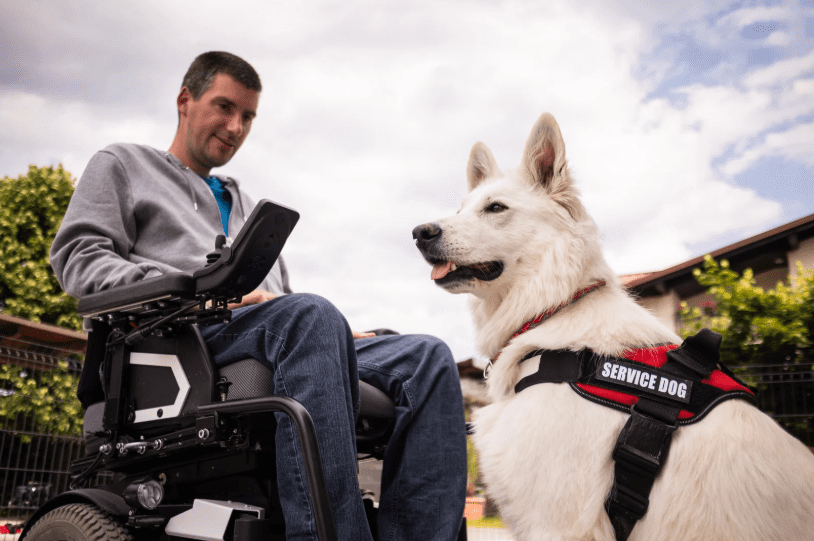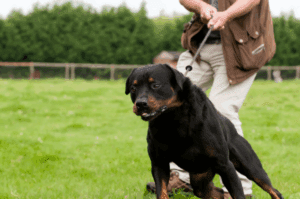Having a service dog can truly change your life if you live with a disability. These dogs offer support in daily tasks, give comfort, and help you feel more independent in different situations.
Learning how to make my dog a service dog means understanding the process from start to finish. This includes legal steps, choosing the right path, and getting proper training through a trusted dog trainer program.
This guide will make each part clear and easy to follow. You’ll learn what it takes, what to expect, and how to move forward with confidence. Let’s break it down in simple terms.
What Is a Service Dog and Who Qualifies
A service dog is taught to perform certain tasks that help a person with a disability in their daily life. Under the Americans with Disabilities Act (ADA), a person must have a physical or mental impairment that limits major life activities. These dogs are not pets, they are working animals with a job to do.
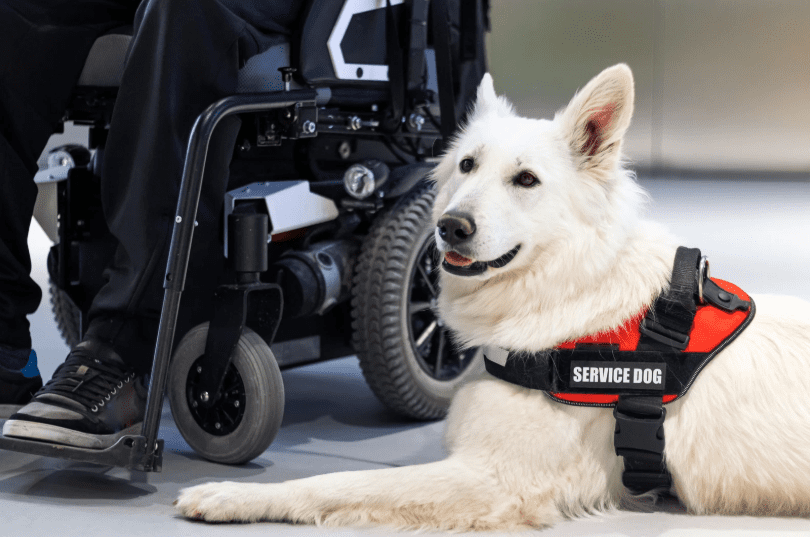
Common examples include dogs trained to alert a person with hearing loss, guide individuals who are visually impaired or assist people during a medical emergency, such as a seizure. If your dog will perform tasks directly related to your disability, they may qualify as a service dog.
Can Any Dog Become a Service Dog
Not every dog is suitable to be a service dog, even if any breed can be considered. A good service dog stays calm, listens well, and stays focused even in noisy places.
Puppies under six months or dogs that are aggressive or very nervous may not be a good fit.
Before you start training, see if your dog is healthy, confident, and friendly with people and other dogs. They should feel okay in crowds and around loud sounds. To help your dog learn more effectively, consider joining a reputable Professional Dog Trainer Program for expert training and support.
Step 1: Evaluate Your Dog’s Personality and Health
Start with a wellness check. Visit your veterinarian to ensure your dog is in good health, up to date on vaccinations, and has no physical limitations. Next, pay close attention to their personality. A future service dog needs to be calm, well-behaved, and ready to learn new things.
If your dog shows signs of stress or aggression in public settings, they may not be ready. Socialization is key, and early exposure to different environments will help your dog become more adaptable over time.
Step 2: Understand the Laws About Service Dogs
In the United States, the ADA grants individuals with disabilities the right to bring their service dogs into public places, including stores, buses, planes, and restaurants. Service dogs do not need to wear a vest or have special papers. They must be trained to do tasks that support their owner’s condition.
You don’t have to sign up your service dog with any national registry. Still, showing proof of training can be beneficial in certain situations. People are not allowed to ask about your disability, but they can ask if the dog is a service dog and what specific task it has been trained to perform.
Step 3: Begin Basic Obedience Training
Whether you train your dog yourself or hire a professional dog trainer, your first step is mastering basic commands. Sit, stay, come, down, and heel are essential. Your dog should respond to commands even in busy environments.
Training should happen in short, focused sessions. Maintain a positive attitude with treats and praise. Repeat lessons daily and build on them gradually. Obedience is the foundation on which all service dog tasks are built, so don’t skip this part.
Step 4: Socialize in Public Environments
Public access training helps your dog stay calm and focused in various real-world settings. Visit parks, malls, buses, and other crowded places. Let your dog experience elevators, shopping carts, and the sounds of traffic.
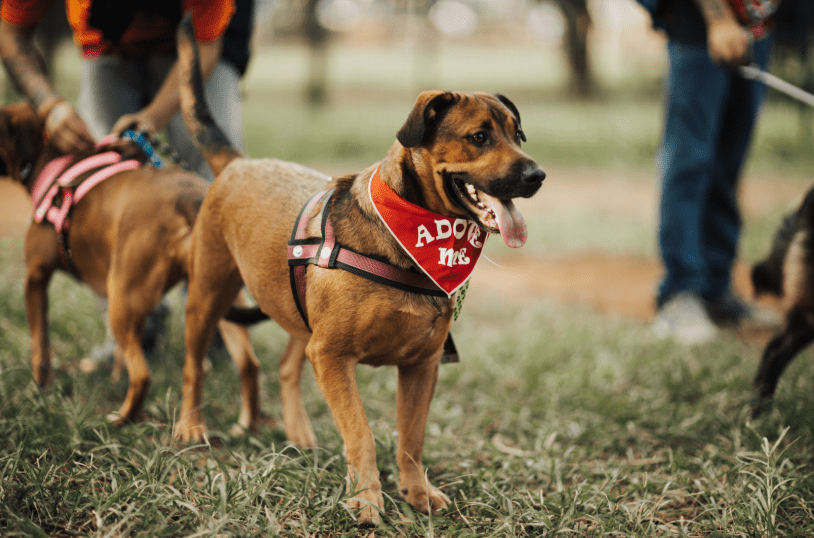
Your goal is to teach your dog to ignore distractions, remain by your side, and follow commands even when people or loud sounds are present. A well-socialized service dog stays steady and alert in any environment.
Step 5: Task-Specific Service Dog Training
This is where your dog learns the specific job that will support your disability. Tasks depend on your needs. Some examples include:
- Picking up dropped items
- Guiding you while walking
- Alerting you to sounds, seizures, or anxiety attacks.
- Applying deep pressure therapy during panic episodes
Each task must be taught carefully, consistently, and with patience. Break the task into small steps and reward success. Repetition helps the dog connect the action with the purpose.
Step 6: Proof of Training and Public Manners
To function well in public, your dog must not bark, lunge, beg for food, or seek attention. Even if your dog is trained to help, poor behavior in public can lead to refusal of entry.
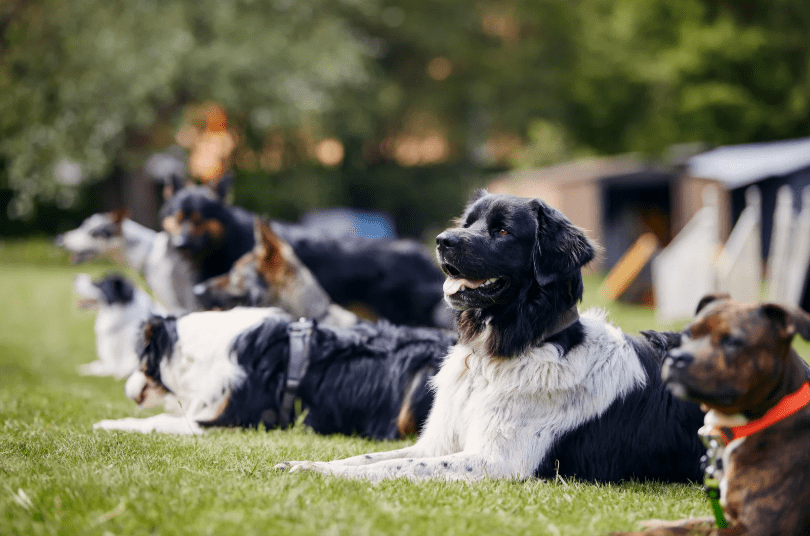
Many service dog handlers work with certified trainers to complete what’s known as a Public Access Test. This test isn’t required by law but can show that your dog behaves appropriately in public. Some organizations offer evaluation and certification for peace of mind.
Step 7: Know When to Hire a Professional Trainer
Self-training a service dog is legal, but it can be overwhelming. If you’re unsure or struggling with a particular task, it’s perfectly fine to ask for help. Certified dog trainers and service dog programs have the experience to guide your dog through complex training.
You can look into board-and-train programs, in-home lessons, or task-specific classes. Ensure the trainer understands ADA requirements and has experience working with service dogs.
Step 8: Practice, Maintain, and Update Training
Service dog training doesn’t end once tasks are learned. Dogs need regular practice to stay sharp. Continue revisiting old commands and introduce new challenges periodically.
As your needs change, you may need to update your dog’s tasks. Lifelong learning keeps your service dog prepared and reliable. Always maintain their health, grooming, and manners to ensure they can serve you well in the long run.
Avoiding Fake Service Dog Claims
It is against the law to call your pet a service dog if it is not. This can cause problems for individuals who genuinely require trained service dogs. A real service dog must be trained to do tasks that help with a disability.
If your dog doesn’t do special tasks, it may be an emotional support animal (ESA), which has fewer rights in public places. K9 Mania Dog Training is a trusted and professional dog training team on Long Island that can help train your dog with the right skills for proper service dog support.
🔗 Learn more about our Board and Train Long Island program.
Frequently Asked Questions
How do I certify my dog as an assistance dog?
To certify your dog as an assistance dog, it needs to learn special tasks that help with a disability. After training, you can get papers or an ID. A true assistance dog must be trained to behave well and help its owner in public.
What are the indicators that a dog is an assistance dog?
An assistance dog usually wears a vest or ID and stays calm in public. It listens to commands and stays close to its owner. These signs show the dog is trained to help someone and should not be bothered while doing its job.
Can anyone call their dog an assistance dog?
You can’t just call any dog an assistance dog. The dog must be trained to help with a real disability. Calling an untrained pet an assistance dog is not allowed and can make things harder for people who truly need help from their dogs.
What age is best for a service dog?
The best age for a service dog to start work is around 1 to 2 years old. By then, the dog is old enough to focus, stay calm, and do helpful tasks. A young, calm, and smart dog makes a great assistance dog.
What Conditions Qualify for a Service Dog?
A person qualifies for a service dog if they have a disability like PTSD, autism, epilepsy, or mobility issues. The dog must perform tasks that help with the person’s daily challenges and medical needs.
Conclusion
Turning your dog into a service dog can improve your life. These dogs give comfort, help with daily tasks, and make you feel more confident. With the right training, your dog can become a loyal and helpful partner every day.
K9 Mania Dog Training will guide you through every step. We’ll help you pick the right dog trainer program and simply explain the rules. We’re here to make the whole process easy and give you the support you need.
If you’re ready to learn how to make my dog a service dog, this is the best time to begin. Call (516) 217-1604 and let us help you build a strong bond with your dog and start this life-changing journey.
End Note
K9 Mania Dog Training offers expert help to turn your dog into a well-behaved companion. With board and train Long Island, we bring one-on-one guidance that fits your dog’s unique needs. Meet the people behind our success on the Our Team page.
We proudly serve many areas and create training plans that work. To see where we train, visit Location Served or reach out through Contact Us. Get helpful tips from our Blog or take the next step in your dog training career at K9 Mania Dog Trainer Academy with our Professional Dog Trainer Program.
Follow our journey and see real training results on Facebook, Instagram, TikTok, and YouTube. To start your dog’s training today, visit K9 Mania Dog Training. We’re here to help every step of the way.

